A block is released on the slant face of a wedge of equal mass placed on a horizontal floor. The slant face of the wedge makes an angle of 45∘ with the floor. Coefficient of friction between all surfaces in contact is the same. Different value/ range of coefficient of friction is given in column I and corresponding consequences in column II and III (wedge is fress to move)
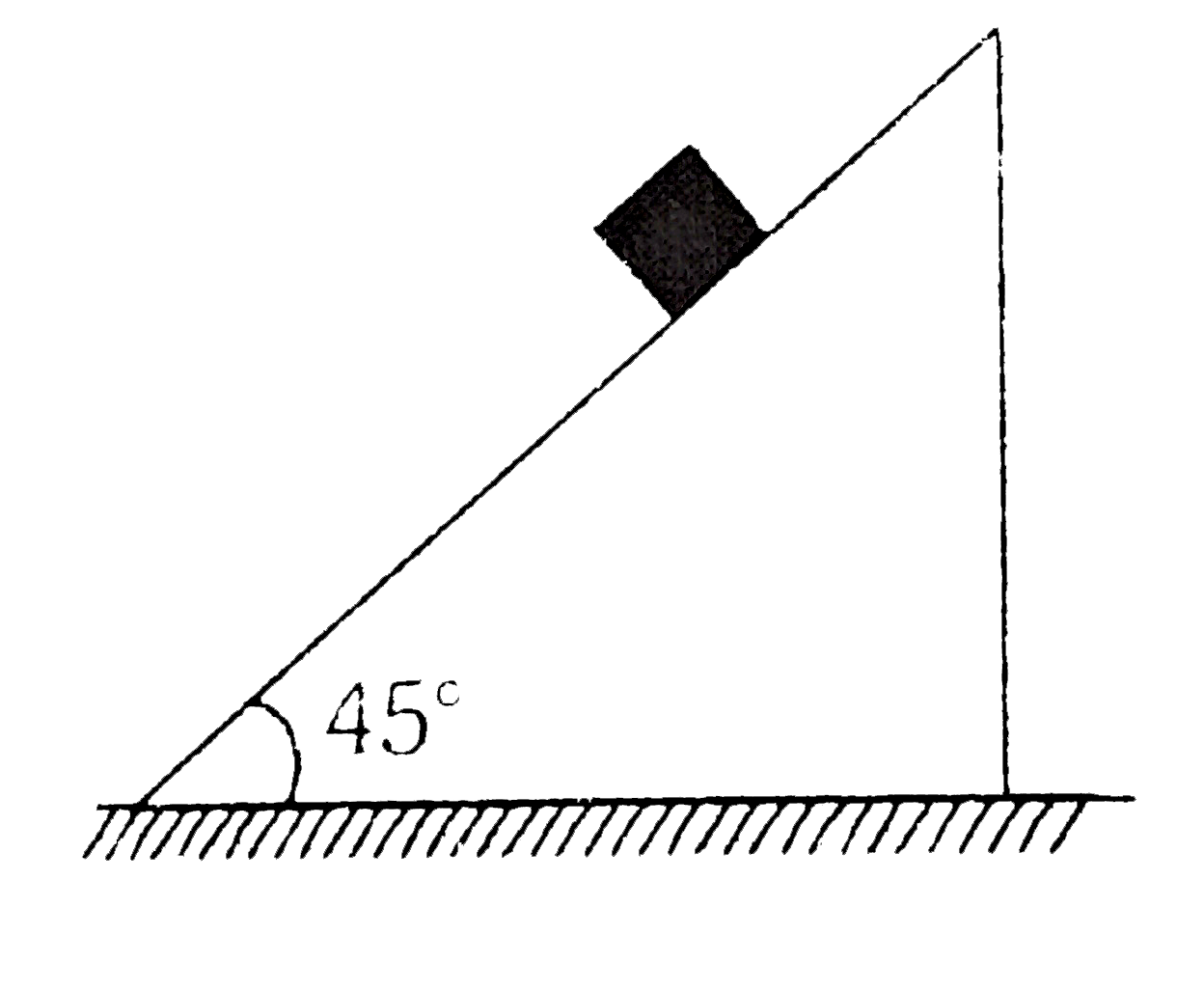
Column-IColumn-IIColumn-III(I)μ=0(i)Work done by friction on block and wedge is negative (on each)(P)Centre of mass of system (block+wedge) moves rightward and downward(II)μ>1(ii)Work done by friction on block is negative but on wedge it is zero(Q)Centre of mass of system (block+wedge) moves leftward and downward(III)√5−2<μ<1(iii)Work done by friction on block and wedge is zero (on each)(R)Centre of mass of system (block+wedge) remains at rest(IV)μ<√5−2(iv)Friction between the block and wedge is static and between the wedge and ground it is kinetic in nature.(S)Centre of mass of system (block+wedge) moves vertically downward
Which of the following options is the correct representation of the case that the wedge remains motionless and the block slides down Solution in Gujrati
(I)(iv)P
(III)(iii)Q
(IV)(i)Q
(II)(iii)(R)
The correct Answer is:C
For block to move μ<tanθ⇒μ<1……(i)
For wedge to move
N√2−μN√2<μN'
μ<√5−2 ....(ii)
Work done by kenetic friction on block and wedge is negative.
Topper's Solved these Questions
- TEST PAPERSBOOK - ALLEN CHAPTER - TEST PAPERSEXERCISE - part-2 physic
48 Videos
- TEST PAPERSBOOK - ALLEN CHAPTER - TEST PAPERSEXERCISE - PHYSICS
16 Videos
- TEST PAPERSBOOK - ALLEN CHAPTER - TEST PAPERSEXERCISE - Part-1 Physics
15 Videos
- TEST PAPER 4BOOK - ALLEN CHAPTER - TEST PAPER 4EXERCISE - PHYSICS
45 Videos
- UNIT & DIMENSIONS, BASIC MATHS AND VECTOR BOOK - ALLEN CHAPTER - UNIT & DIMENSIONS, BASIC MATHS AND VECTOR EXERCISE - Exercise (J-A)
7 Videos
Similar Questions
In a continuous printing process paper is drawn into the press at a constant speed v. Denoting by 'r' the radius of the paper roll at any given time and by 'b' the thickness of the paper. What is the angular acceleraion of the paper roll?
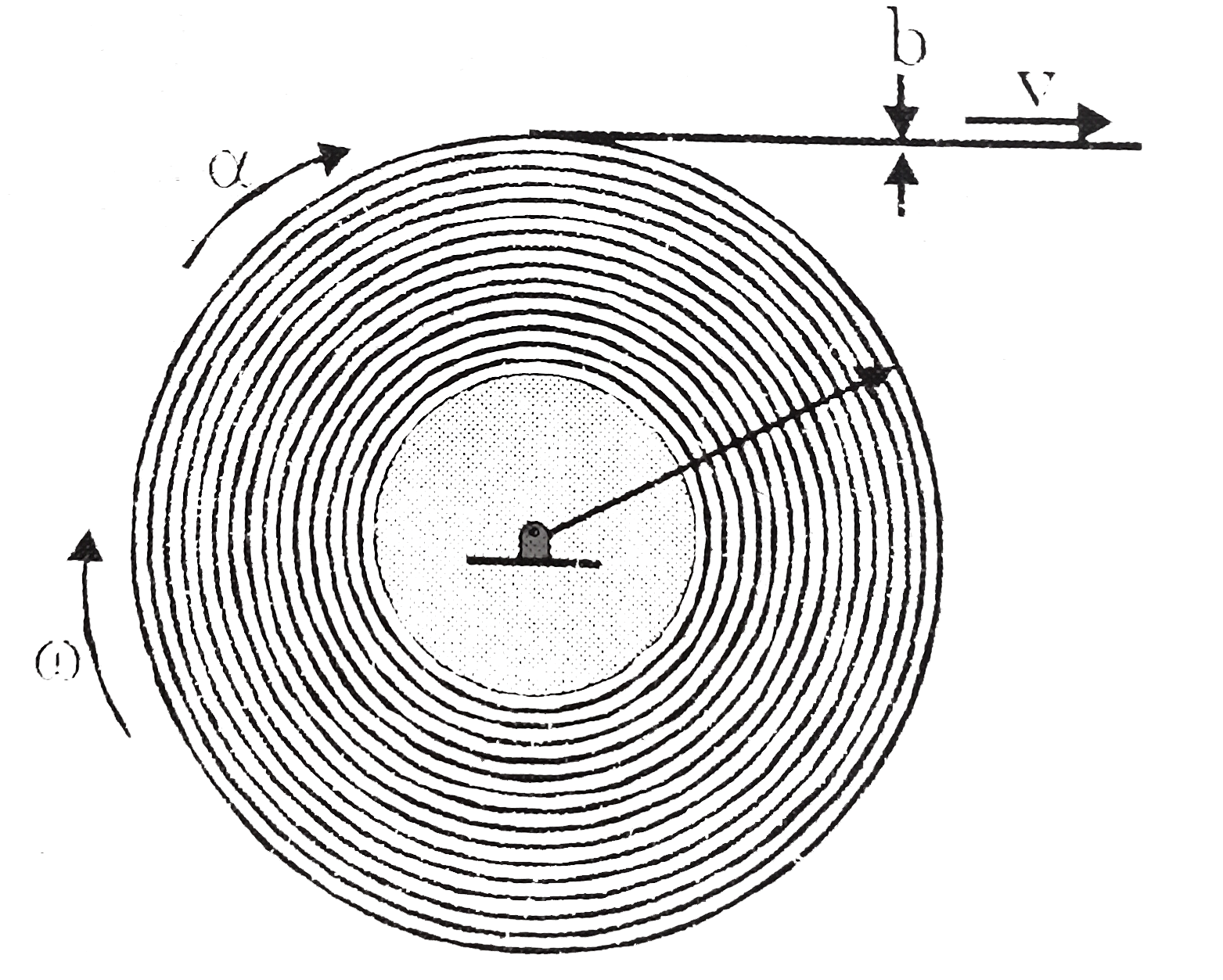
View SolutionA block of mass m is hanging from a light string of length l . A bullet of mass m strikes the hanging mass and gets embedded into it. The value of v such that tension in string and the speed of combined mass becomes zero simultaneously during the subsequent motion , is :-

View SolutionA quantity of 2 mole of helium gas undergoes a thermodynamic process, in which molar specific heat capacity of the gas depends on absolute temperatureT , according to relation:
C=3RT4T0
where T0 is initial temperature of gas. It is observed that when temperature is increased. volume of gas first decrease then increase. The total work done on the gas until it reaches minimum volume is :-
View SolutionTwo forces, each of magnitude F have a resultant of the same magnitude F. The angle between the two forces is
View SolutionMatch List I with List II and select the correct answer using the codes given below the lists :

View SolutionThe coefficient of friction between the block A of mass m and the triangular wedge B of mass M is μ. There in no friction between the wedge and the plane if the system (block A+ wedge B) is released so that there is no stiding between A and B find the inclination θ

View SolutionA block A of massm which is placed a rough inclined face of a wedge of same mass being pulled through light string and with force F as shown in figure The coefficient of friction between inclined face and block A is μ while there is no friction between the ground and wedge it the whole system moves with same acceleration then find the value of F
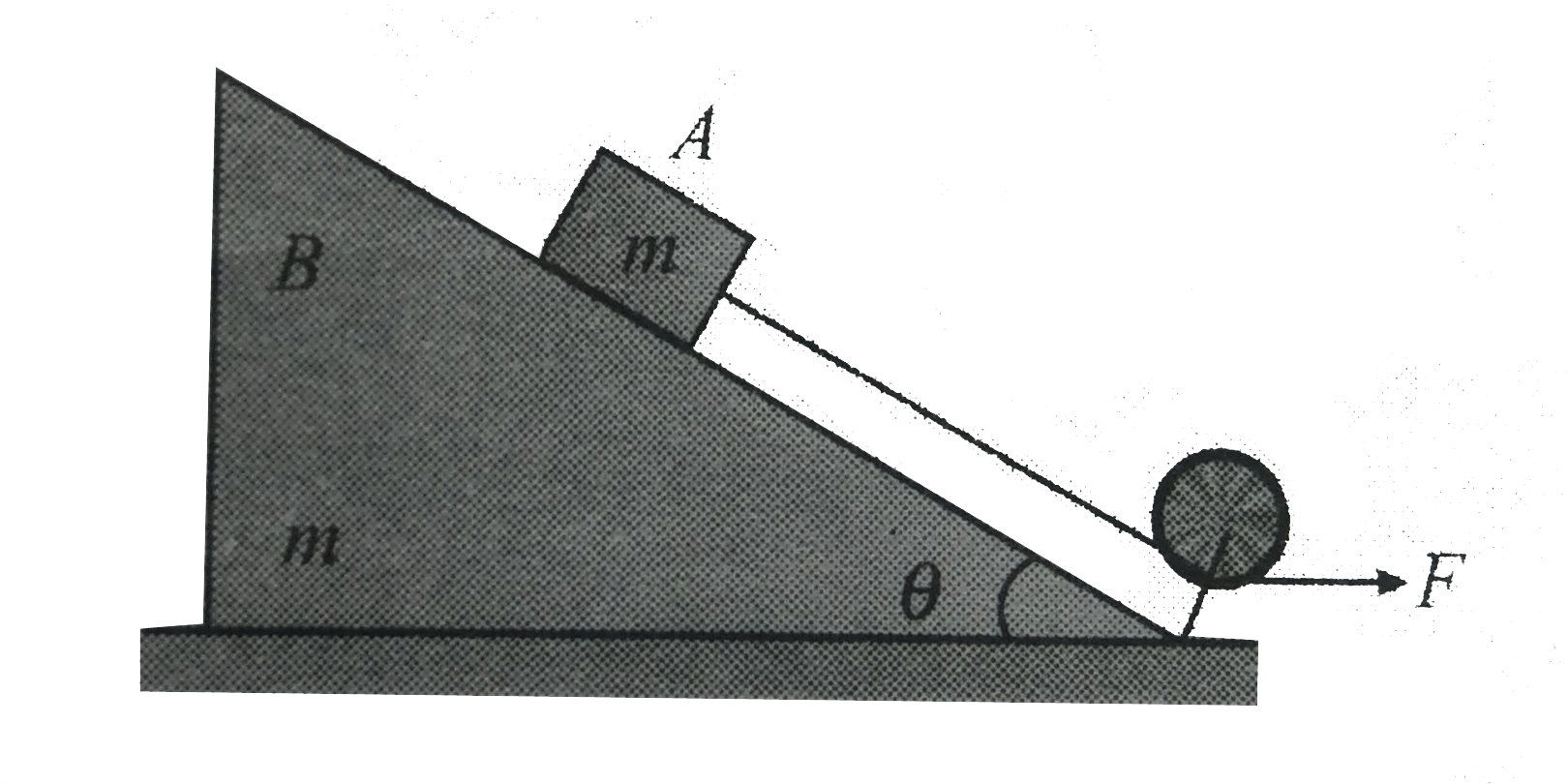
View SolutionCalculate angle of friction between wedge and block system is at rest M coefficient of friction between wedge and block.
View SolutionFigure shows an irregular wedge of mass m placed on a smooth horizontal surface. Part BC is rough. If the coefficient of friction between the block and wedge is mu , and the block comes to rest with respect to wedge at a point E on the rough surface then BE will be
View SolutionA wedge B of mass 2 m is placed on a rough horizontal suface. The coefficient of friction between wedge and the horizontal surface is mu_(1) . A block of mass m is placed on wedge as shown in the figure. The coefficient of friction between block and wedge is mu_(2) . The block and wedge are released from rest. Q. Suppose the inclined surface of the wedge is at theta=37^(@) from angle from horizontal and mu_(2)=0 are wedge will remain in equilibrium if
View SolutionA block is released on the slant face of a wedge of equal mass placed on a horizontal floor. The slant face of the wedge makes an angle of 45∘ with the floor. Coefficient of friction between all surfaces in contact is the same. Different value/ range of coefficient of friction is given in column I and corresponding consequences in column II and III (wedge is fress to move)
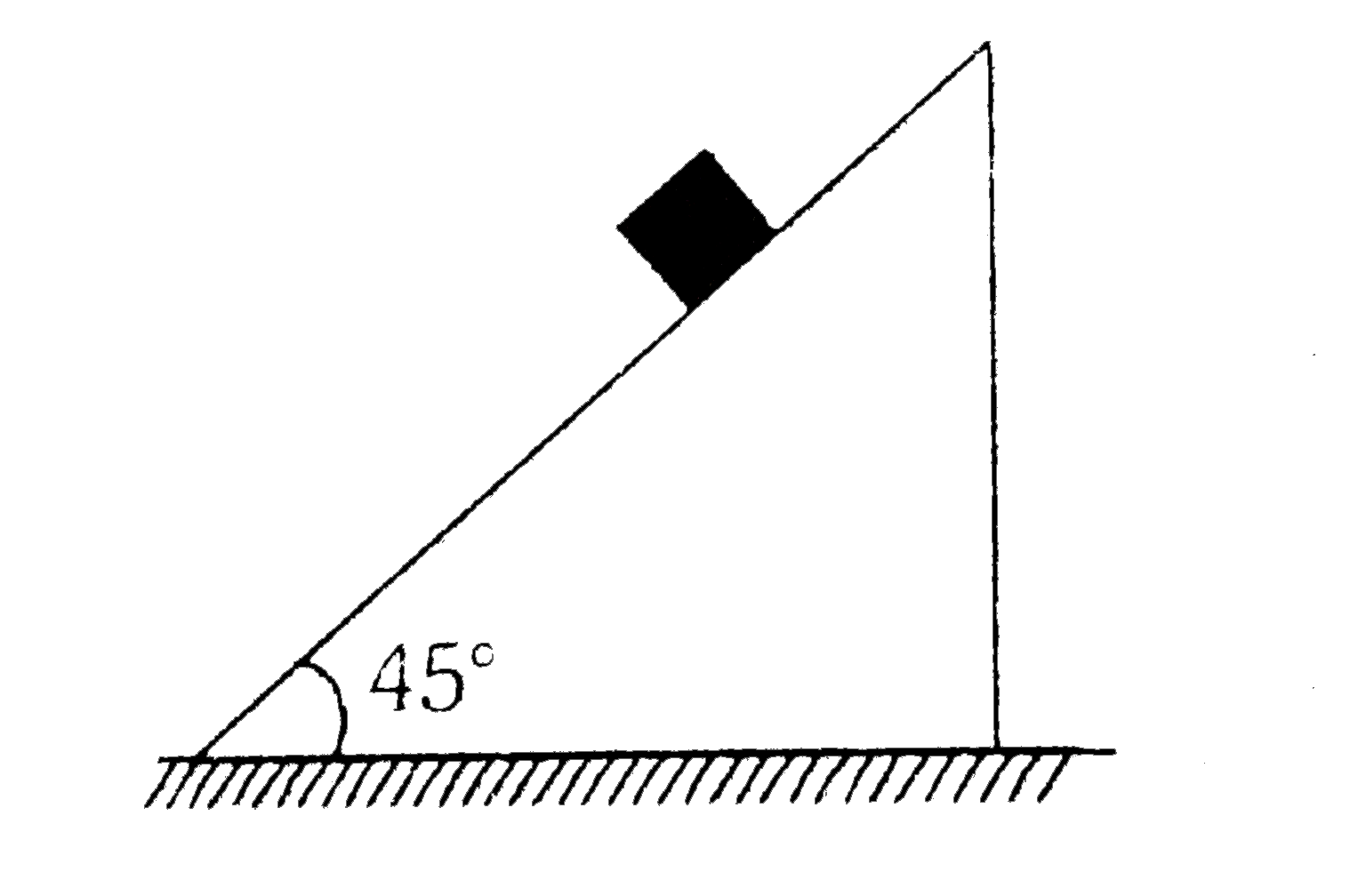
Column-IColumn-IIColumn-III(I)μ=0(i)Work done by friction on block and wedge is negative (on each)(P)Centre of mass of system (block+wedge) moves rightward and downward(II)μ>1(ii)Work done by friction on block is negative but on wedge it is zero(Q)Centre of mass of system (block+wedge) moves leftward and downward(III)√5−2<μ<1(iii)Work done by friction on block and wedge is zero (on each)(R)Centre of mass of system (block+wedge) remains at rest(IV)μ<√5−2(iv)Friction between the block and wedge is static and between the wedge and ground it is kinetic in nature.(S)Centre of mass of system (block+wedge) moves vertically downward
Which of the following option is the correct representartion of the case that both the bodies remain motionless-
View SolutionA block is released on the slant face of a wedge of equal mass placed on a horizontal floor. The slant face of the wedge makes an angle of 45∘ with the floor. Coefficient of friction between all surfaces in contact is the same. Different value/ range of coefficient of friction is given in column I and corresponding consequences in column II and III (wedge is fress to move)

Column-IColumn-IIColumn-III(I)μ=0(i)Work done by friction on block and wedge is negative (on each)(P)Centre of mass of system (block+wedge) moves rightward and downward(II)μ>1(ii)Work done by friction on block is negative but on wedge it is zero(Q)Centre of mass of system (block+wedge) moves leftward and downward(III)√5−2<μ<1(iii)Work done by friction on block and wedge is zero (on each)(R)Centre of mass of system (block+wedge) remains at rest(IV)μ<√5−2(iv)Friction between the block and wedge is static and between the wedge and ground it is kinetic in nature.(S)Centre of mass of system (block+wedge) moves vertically downward
Which of the following options is the correct representation of the case that the wedge remains motionless and the block slides down
View SolutionA block is released on the slant face of a wedge of equal mass placed on a horizontal floor. The slant face of the wedge makes an angle of 45∘ with the floor. Coefficient of friction between all surfaces in contact is the same. Different value/ range of coefficient of friction is given in column I and corresponding consequences in column II and III (wedge is fress to move)

Column-IColumn-IIColumn-III(I)μ=0(i)Work done by friction on block and wedge is negative (on each)(P)Centre of mass of system (block+wedge) moves rightward and downward(II)μ>1(ii)Work done by friction on block is negative but on wedge it is zero(Q)Centre of mass of system (block+wedge) moves leftward and downward(III)√5−2<μ<1(iii)Work done by friction on block and wedge is zero (on each)(R)Centre of mass of system (block+wedge) remains at rest(IV)μ<√5−2(iv)Friction between the block and wedge is static and between the wedge and ground it is kinetic in nature.(S)Centre of mass of system (block+wedge) moves vertically downward
Which of the following options is the correct representaion of the case that the block slides down the wedge and wedge slide on the floor
View SolutionA wedge of mass M makes an angle θ with the horizontal. The wedge is placed on horizontal frictionless surface. A small block of mass m is placed on the inclined surface of wedge. What horizontal force F must be applied to the wedge so that the force of friction between the block and wedge is zero ?
View Solutiona Block of mass m is placed on a wedge of mass M there is no friction between the block and the wedge .The minmum coefficient of friction between the wedge and the gound so that wedge does not move is,
View SolutionA small block of mass m is kept on the inclined surface of a wedge of mass M. The inclined surface of the wedge makes an angle θ with the horizontal. The wedge is kept on a frictionless rigid horizontal floor. You can neglect friction between the block and the wedge also. An external agent applies a horizontal force F on the wedge.
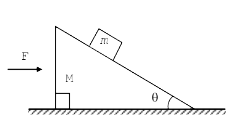
The value of the force F so that the wedge remains at rest is F1. Which of the options is incorrect?
View Solution
